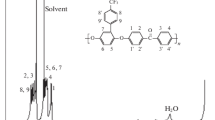Conclusions
-
1.
By the replacement of carbonyl oxygen in ar-hydroxy-acetophenones and -biacetophenones by chlorine and treatment of the chlorides formed with sodamide, mono- and di-acetylenic phenols were obtained.
-
2.
By the oxidative polycondensation of a diethynylbiphenol dibenzoate a polymer was prepared which contained both diacetylenic chains and benzoyloxy groups.
-
3.
O-Ethynylphenols are much more stable than their para isomers and do not undergo oxidative condensation. The corresponding dimers were prepared via the benzoyl derivatives.
Similar content being viewed by others
Literature cited
I. L. Kotlyarevskii and M. I. Bardamova, Izv. AN SSSR, Ser. khim.,1964, 2073.
K. W. Rosenmund and H. Lohfert, Ber.,61, 2601 (1928).
L. F. Fieser and C. Bradsher, J. Amer. Chem. Soc.,58, 1741 (1936).
Nara Boon-Long, J. Pharm. Assoc. Siam.,1, N 4, 5 (1948).
Author information
Authors and Affiliations
Additional information
Translated from Izvestiya Akademii Nauk SSSR, Seriya Khimicheskaya, No. 3, pp. 658–662, March, 1967.




